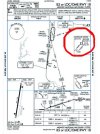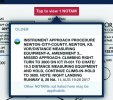NorthEast Ohio
Pre-takeoff checklist
- Joined
- Jul 4, 2020
- Messages
- 194
- Display Name
Display name:
NorthEast Ohio
Upper left, above "RADAR required".Nowhere on this plate do I see GPS is required. So, How do you do the missed approach procedure?
The FAA wanted to sound Continental.AIM 1-2-2 explains RNP, but the explanation is not very good in my opinion. To me, the FAA seems to have used nomenclature that is needlessly confusing.
Thank you for the info. So I guess that means if there’s some kind of RAIM prediction/GPS outage you will not be able to fly a GPS approach nor have the ILS as a back up.
I've heard it going to change again. Like a lot of changes in nomenclature over the past 30 years or so, it's all about recognizing that aviation is international.The FAA wanted to sound Continental.
I think I’m turning European
i think I’m turning european
i really think so!
Yeah, I’m just a little salty about some stuff my company does to penalize non-EASA pilots.I've heard it going to change again. Like a lot of changes in nomenclature over the past 30 years or so, it's all about recognizing that aviation is international.
91.175 Takeoff and landing under IFR.Thank you for the info. So I guess that means if there’s some kind of RAIM prediction/GPS outage you will not be able to fly a GPS approach nor have the ILS as a back up.


What's behind the "cross NEBTE at or below 2000" I'm not sure I have ever seen that on a missed procedure.
That's actually the PBN Requirements Box. Any equipment listed there is required equipment just as if it was in the Equipment Requirements Box
That's actually the PBN Requirements Box. Any equipment listed there is required equipment just as if it was in the Equipment Requirements Box
None of the Approaches at Newark have an Alternate Missed Approach. Here's an excerpt from the latest Amendment to the ILS or LOC RWY 4R, effective 05/10/2023 explaining why.91.175 Takeoff and landing under IFR.
(a) Instrument approaches to civil airports. Unless otherwise authorized by the FAA, when it is necessary to use an instrument approach to a civil airport, each person operating an aircraft must use a standard instrument approach procedure prescribed in part 97 of this chapter for that airport
§ 91.187 Operation under IFR in controlled airspace: Malfunction reports.
(a) The pilot in command of each aircraft operated in controlled airspaceunder IFR shall report as soon as practical to ATC any malfunctions of navigational, approach, or communication equipment occurring in flight.
(b) In each report required by paragraph (a) of this section, the pilot in command shall include the—
(1) Aircraft identification;
(2) Equipment affected;
(3) Degree to which the capability of the pilot to operate under IFR in the ATC system is impaired; and
(4) Nature and extent of assistance desired from ATC.
Some locations have a preplanned alternate
missed approach procedure for use in the event the
primary NAVAID used for the missed approach
procedure is unavailable. To avoid confusion, the
alternate missed approach instructions are not
published on the chart. However, the alternate missed
approach holding pattern will be depicted on the
instrument approach chart for pilot situational
awareness and to assist ATC by not having to issue
detailed holding instructions. The alternate missed
approach may be based on NAVAIDs not used in the
approach procedure or the primary missed approach.
When the alternate missed approach procedure is
implemented by NOTAM, it becomes a mandatory.
View attachment 120408
View attachment 120409
Short of declaring an emergency, I think you are out of luck being issued an approach for 4R at EWR with an RNAV failure.
He noted that you directed the OP to the wrong place on the chart, and provided information regarding the correct place on the chart.What additional information are you providing? I have no idea what the point of your comment is and why you quoted me.
He noted that you directed the OP to the wrong place on the chart, and provided information regarding the correct place on the chart.
You see a below restriction from time to time in busy airspace to keep you below other traffic.What's behind the "cross NEBTE at or below 2000" I'm not sure I have ever seen that on a missed procedure.
Didn’t claim it did, was noting how available alternate missed procedures are now charted and they are always based on a loss of a miss approach based on ground navaid.None of the Approaches at Newark have an Alternate Missed Approach. Here's an excerpt from the latest Amendment to the ILS or LOC RWY 4R, effective 05/10/2023 explaining why.
CHANGES - REASONS
- INCORPORATED APPLICABLE CHANGES FROM FDC 1/7776, 0/2604, AND 7/7220.
- TERMINAL ROUTES: CHANGED MISSED APPROACH INSTRUCTIONS FROM “CLIMB TO 600 THEN CLIMBING RIGHT TURN TO 2500 ON HEADING 060 AND TEB VOR/DME R-205 TO TEB VOR/DME AND HOLD” TO “(DO NOT EXCEED 210 KIAS UNTIL NEBTE) CLIMB TO 560 THEN CLIMBING RIGHT TURN TO 2000 DIRECT TYNIE THEN LEFT TURN ON TRACK 014.97 TO NEBTE, CROSS NEBTE AT OR BELOW 2000 THEN CLIMBING LEFT TURN TO 3000 ON TRACK 313.46 TO FLYRS AND HOLD, CONTINUE CLIMB-IN-HOLD TO 3000.” - FPT INITIATED CHANGE TO GIVE ALL RUNWAY 4R/4L PROCEDURES AT EWR THE SAME RNAV MISSED APPROACH PROCEDURE. FPT CHECKLIST CALLED FOR MANDATORY 2000 MSL CROSSING ALTITUDE AT NEBTE; COORDINATION CONFIRMED INTENT WAS “AT OR BELOW 2000 AT NEBTE”.
- DELETED ALTERNATE MISSED APPROACH - FPT REQUEST, NOT REQUIRED DUE TO ADDITION OF RNAV MISSED APPROACH
kinda the object.I guess I learned something. There is a distinction between required equipment notes and PBN notes even though they are essentially co-located on the chart.
Yeah. They usually have a Note saying descent to at or below[altitude] may be required when executing an early missed approach.You see a below restriction from time to time in busy airspace to keep you below other traffic.
AIM 1-2-2 explains RNP, but the explanation is not very good in my opinion. To me, the FAA seems to have used nomenclature that is needlessly confusing. But to fly RNAV procedures and use of WAAS GPS, you must understand it.
@RussR has a decent explanation of required equipment on his website.
Goodbye /DME, Hello Equipment Requirements Notes!
Bruce Williams has a pretty good video about all that.The PBN equipment box specifies requirements for any required PBN equipment. At one point this might have read as "GPS required" or later as "RNAV 1 - GPS required". This is because the path followed on the missed approach required use of a GPS and the path was RNAV 1. Unfortunately not all GPS that are IFR approach capable meet the RNAV 1 PBN specification requirements, example KLN90B, KLN94, GNC300XL, and others. However, there is a PBN specification that is used to define what we would have in the past called a GPS approach. The PBN specification is named "RNP APCH" and includes provisions for using RNAV 1 segments as part of the approach procedure, so since all the GPS systems including those I mentioned, comply with "RNP APCH", using this specification in the PBN box, effectively allows any GPS that is certified for IFR to be used to satisfy the equipment requirement. "RNP APCH" is simply the name of the PBN specification used to define a GPS system that is capable of flying a GPS approach. In this instance, it is only needed for the missed approach segment, sometimes the same specification can be used for the initial segment to join the conventional approach procedure. As VOR get discontinued, you will see more and more dependence on hybrid procedures, using RNP APCH to join the procedure, determine an ATD, or to execute the MAP. Pretty much all RNAV (GPS) approach procedures will also have "RNP APCH - GPS" specified in the PBN equipment box.
ICAO has changed the names of what we termed GPS approach and now as a RNAV (GPS) approach to use the terminology RNP. US decided not to change their approach names for the second time to RNP, but did agree to add the PBN equipment box and specify "RNP APCH" as the requirement. We in the US have been using these GPS approaches since the mid 1990's, like 30 years or so, whereas for the rest of the world, they are just getting into using them, so as the new kids on the block, they could not adopt our naming conventions and made their own. When they came up with these changes there were very few procedures that they had to update, while in the US we had thousands and thousands of them already published. They call GNSS rather than GPS because in theory there are all sorts of GNSS systems deployed, but for all practical purposes only one is being used for navigation, the US military GPS system. There are other SBAS systems in use that are compatible with WAAS, but they rely on the US GPS system.
Those locations are missed approaches based on ground navaids. In some cases, it even uses the same intersection, but defined differently.Some locations have a preplanned alternate
missed approach procedure for use in the event the
primary NAVAID used for the missed approach
procedure is unavailable.
Which Navaids are not ground based? Even most RNAV has a ground component.Those locations are missed approaches based on ground navaids. In some cases, it even uses the same intersection, but defined differently.
It may not be 100% pure technically correct, but I think most generically consider VOR, Localizer, NDB and other traditional systems as "ground-based" as opposed to sattelite systems, even if enhanced by a ground component.Which Navaids are not ground based? Even most RNAV has a ground component.
No, but most people, including the FAA, define NAVAIDS as physical devices on the ground that aircraft can detect and fly to. What I posted was a cut and paste from a FAA source that seemed to confuse you.It may not be 100% pure technically correct, but I think most generically consider VOR, Localizer, NDB and other traditional systems as "ground-based" as opposed to sattelite systems, even if enhanced by a ground component.
If my use that term in that way confuses you, I apologize.
